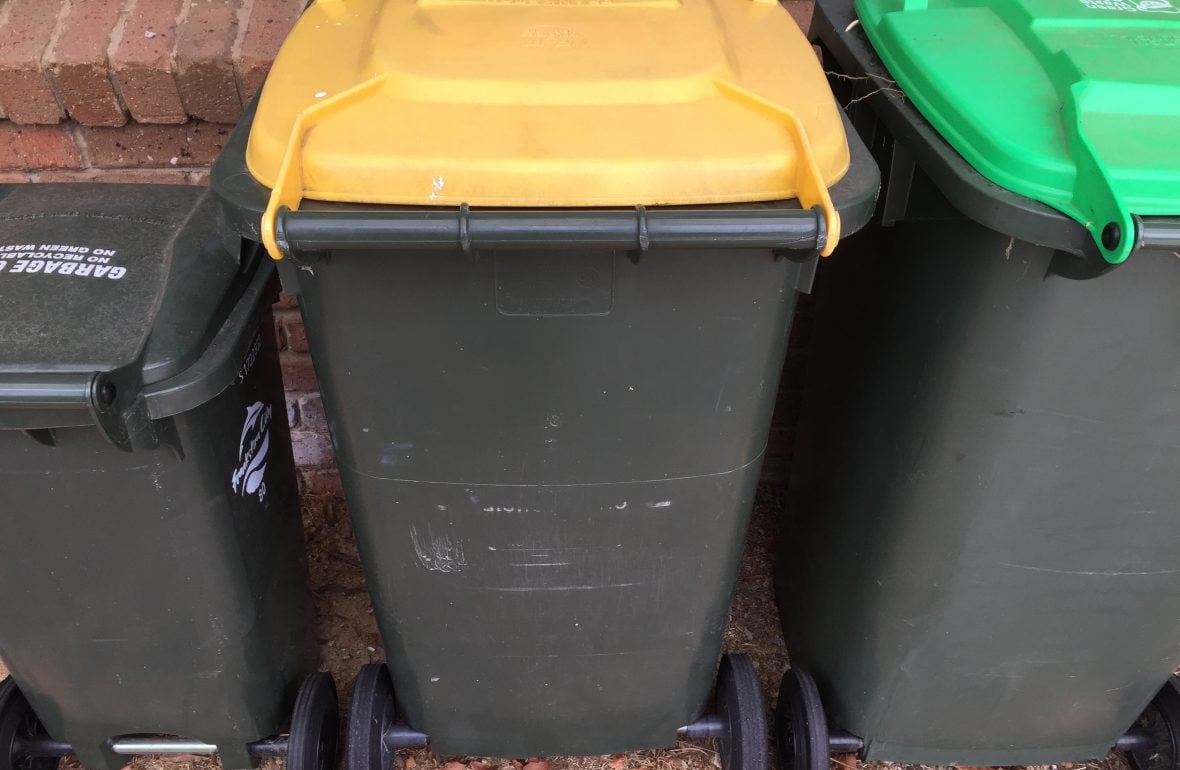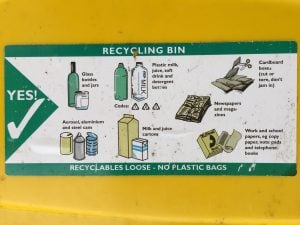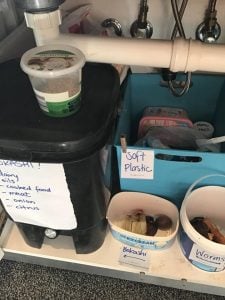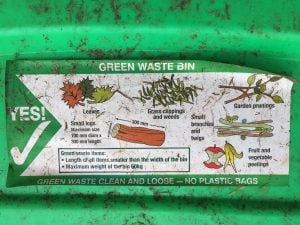
Wanna hear me talk rubbish? We all have it. And it’s got to go somewhere, right? I’m going to break down how my family sorts our waste.
But first, a bit about us. Just so you know, we are far from zero waste, but I would consider us a reasonably ‘low waste’ family. There are 5 of us; 3 adults and 2 kids. And a dog. Just a regular family, who eat regular food and shop at a regular supermarket. Anyone can sort rubbish like us if you learn to do it right. So this is what we do…

Recycling: Most homes have a yellow-lid kerbside recycling bin for bottles, cans, papers, boxes, balled foil etc. (It’s preferable to make sure items are reasonably clean too). Our bin has a sticker inside the lid which shows what can go in but occasionally we come across a random bit of rubbish and wonder what to do with it. There’s some helpful websites I use to look up items: Planet Ark’s recyclingnearyou.com.au and also my local council website which has an A-Z recycling guide. But “if in doubt, leave it out!” and put it in the rubbish bin as contaminated recycling bins can sometimes not be collected at all.

Food scraps: Under our sink we have two containers; one for the worm farm and one for the Bokashi bin. The worms get our fruit and vegetable scraps. The Bokashi bin gets everything else. This wonderful bin is a “pre-composter” which uses microbes and an anaerobic environment to start the breakdown process. It can take meat, dairy, oils, citrus and onion (which the worms don’t like). I’ll go deeper into the Bokashi bin in another post.
Soft plastics: Ah, soft plastics! Once this stuff was separated we noticed a big decrease in how much went into the regular rubbish bin. Soft plastics are considered to be any plastics that can be scrunched easily; bread bags, rice/pasta packets, frozen food packets, chip packets (even ones with silver inside), plastic produce bags… the list goes on. We keep soft plastics in a box under the sink and when it’s full we take it to the supermarket to be recycled via Redcycle. The trick here is to remember to take it! For a full list of what is accepted go to www.redcycle.net.au.
Other recycling: There are a few recycling programs around that collect specific waste items. One is Terracycle and currently they have a competition for schools to collect oral care waste. It’s called the Colgate Community Garden Challenge and basically this program collects used toothbrushes, empty toothpaste tubes, floss containers and associated packaging. This waste is diverted from landfill and used to make recycled garden items. I signed our local primary school up and started a collection point in the office. So we keep that stuff aside and take it to the school.
We also separate other items including:
*plastic bottle tops (Envision are making recycled plastic prosthetic hands)
*bread tags (Bread tags for Wheelchairs on Facebook)
*batteries – Aldi have a collection point for dead batteries
These waste items go into small containers until full and then we drop them off at various collection points when it’s convenient.

Compost/Green waste: We have home compost bins made from repurposed pipes (same as in our strawberry patch) that are located right down in the depths of the backyard. Usually we just use these for grass clippings, leaves and general garden waste, but sometimes excess food scraps and coffee grounds go in here too. Once broken down, the compost is used on our garden.
We also use the council green waste bin for larger stuff like garden prunings, branches and roots. Stuff that’s too big or will take longer to break down in our compost bin. We do have a very large backyard so this bin is often filled to the top, as you can probably tell by the grotty-looking sticker (located under the bin lid) in the photo!
Landfill: The last resort. Let’s take a look in ours right now shall we? I’ve found tissues, dog food packaging (probably should have been washed and put with soft plastics), waxed baking paper, the round bit from inside the milk bottle lid, a nappy (there’s a whole other post in itself) and other gross stuff I don’t fancy rummaging around in. Our general waste has severely decreased since we have been really trying to sort properly and reduce in the first place. Usually we have one small bag of rubbish each week. I contacted our council last year to see if we could swap our standard size rubbish bin for a smaller one. They were happy to swap it over and now we save ourselves around $70 a year on our rates! Win win.
But wait, there’s more!
There’s the clothing that’s too small or unworn, the old toys and books that the kids don’t use, the appliances we don’t want anymore. All this stuff can be passed on or donated if it’s still in good condition. There are plenty of places that will accept these items including kindergartens/playgroups, libraries, op shops, online marketplaces … There are heaps! This stuff doesn’t have to go to landfill. This is a topic for another time.


Great blog Andrea!
Well done finally putting this together I’m loving watching your new journey begin!
It’s exciting times! I feel like I have much to say so get ready! Glad you’re enjoying it so far.
This is so great, thanks for sharing. I had no idea Aldi took old batteries – I hate throwing them in the bin so that’s awesome!
Thank you for reading!